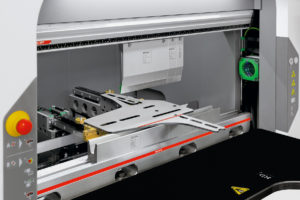 As innovative hardware and software technologies have been introduced into modern CNC press brakes, the skill sets required to operate these machines have changed dramatically. Consequently, with the introduction of new innovative machine technologies, tasks have become simpler and less time consuming and overall productivity has increased. The press brake’s ability to produce more products over time has enabled higher machine capacity and machine utilization. Technology has also further perfected the quality of the finished parts — with dynamic crowning, thickness detection, frame deflection, temperature compensation, 3-D graphical bend sequencing and precision ground quick-change tooling.
As innovative hardware and software technologies have been introduced into modern CNC press brakes, the skill sets required to operate these machines have changed dramatically. Consequently, with the introduction of new innovative machine technologies, tasks have become simpler and less time consuming and overall productivity has increased. The press brake’s ability to produce more products over time has enabled higher machine capacity and machine utilization. Technology has also further perfected the quality of the finished parts — with dynamic crowning, thickness detection, frame deflection, temperature compensation, 3-D graphical bend sequencing and precision ground quick-change tooling.
Familiar User Interface
One of the most noticeable features of a modern CNC press brake is the operator control interface. A large full touch screen display with screen control functions similar to today’s smart phone and tablets presents an easy learning interface for first time users. Gone are the intimidating operator interfaces with a myriad of buttons, switches and dials… not to mention poor graphics. From a recruitment perspective in attracting new hires, providing a user interface that recruits are already familiar with (touch screens) in their smart phones and tablets, already makes operating a press brake less intimidating and more attractive to first time press brake users.
Technology Bridges Experience for Press Brake Set-up and Operations
What about bending experience? With regard to older press brakes, the experience that used to be required was mostly in the press brake set-up itself. In fact some companies had a dedicated supervisor that would just do set-ups and then hand off the machines to a less experienced operator. That is no longer necessary. Today’s modern CNC press brakes have features and built in “smart technologies” that intelligently guide even a novice user through press brake setups and operations. For example:
- Offline programming has freed the requirements of operators needing to be trained in part programming.
- Bar code scanning of the part ID has enabled the error proof loading of the correct part program; Graphical and LED tool mapping displays show the operator exactly where each tool needs to be loaded and which type of tooling.
- 3-D graphical simulations of the bending sequence prior to bending allow the operator to visualize the bending process beforehand. If required, bend re-sequencing is achieved by dragging and dropping a bend step before or after another, directly on the screen. CNC back gauge axes are also graphically displayed in the case where a specific part of the back gauge is being used for part positioning.
- Bending line laser projects a visible laser line directly centered to the v-die opening to assist operators with visualizing the location of the bend angle on the part prior to bending.
Smart Technologies
There are “smart technologies” that are built into the modern CNC press brakes that directly impact not only the quality of the finished parts but the experience level required of the operator. With these smart technologies, the experience no longer resides with the operator, but within the machine itself. For example:
- Automatic dynamic crowning ensures that your angles are consistent along the entire bend length.
- Thickness detection accounts for material thickness deviations and automatically re-calculates the new bottom dead center of the bend angle.
- Mechanical compensations also include frame deflections which can vary depending on the applied tonnage and temperature compensation for the hydraulic system as it affects the frame.
- Laser angle measuring systems measure and adjust each angle during bending to ensure consistency in bend angle accuracy independent of material properties.
Achieving More with Less
The combination of modern control interfaces combined with innovative ‘smart technologies” already contained within the machine control, makes finding new press brake operators much easier and more productive from the very start. Utilizing modern CNC press brake technologies and control software technologies working in unison as a process, will achieve more with less; more quality with less skill set, more productivity with less labor and more capacity with less machines.
By Frank Arteaga, Head of Product Marketing, NAFTA Region
Bystronic Inc., Elgin, IL – Voice.bystronic@bystronic.com
